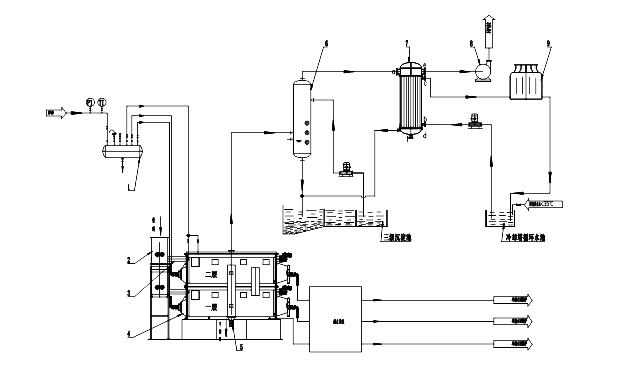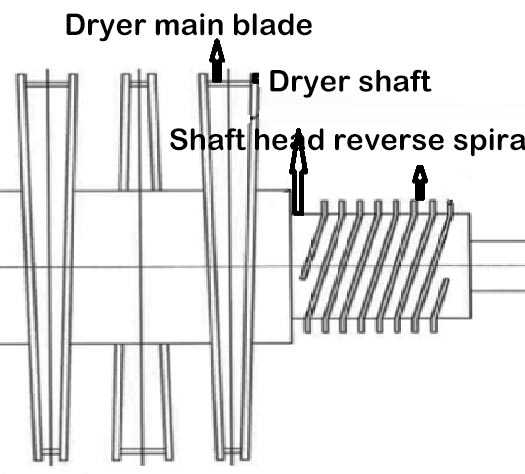First, Paddle dryer design
The RD-Paddle dryer design process consists of nine parts, namely:
1. Sub-cylinder 2. Buffering silo 3. Cloth spiral 4. Drying main unit of RD (two stages) 5. Discharge spiral 6. Wet dust collector 7. Condenser 8. Induced draft fan 9. Cooling tower

You can also browse more about the working principle and equipment classification of the paddle dryer.
Second, the design and development of multi-effect drying method for the purpose of energy saving
The RD multi-effect drying method is a dry energy-saving process developed by Luoyang Ruidao Drying Engineering Co., Ltd. according to the characteristics of the conduction heating dryer and the application properties of the steam heat source. The dry and volatilized secondary steam is subjected to heat-filtering, dust-removing, and becomes a heat source that can be used for drying, thereby achieving energy-saving purposes. RD multi-effect drying method together with RD multi-stage multi-stage multi-effect drying device, RD liquid drying machine and RD continuous vacuum drying device form a complete conduction heating drying system.
Third, increase production and ensure the stability of feeding, we have developed the feeding system
The control system is equipped with automatic and semi-automatic control systems, which makes the labor intensity lower and the product quality stable. The application of computer technology, most of the large-scale systems use computer technology to collect the system parameters. In practical applications, the dryer passes. When the screw conveyor realizes feeding, the screw shaft of the screw conveyor adopts a double support structure to pass through the dryer, that is, the transmission end of the screw shaft is supported by two sets of bearings, and the tail end of the screw shaft is provided with a bearing support. As far as the feeding unit is concerned, the satisfactory level of feeding has not been achieved, and the feed stability is not good enough. The company specializes in the comprehensive utilization technology and drying equipment for the harmless, reduced and resourced industrial waste. And production, in response to the above problems, the project is currently developing a stable feed system.
Development results of the paddle dryer loading system
- We have developed a stable and reliable feeding system;
- The original shaftless screw conveyor is designed with a reverse thrust spiral according to the characteristics of the material;
- The vibrating rod and the power device are added in the feeding system, which not only ensures the smooth operation of the system feeding module, but also promotes the stability of the feeding system and increases the processing amount;
- Developed a liquid feeding device, using static painting technology and method, embedded in the PLC solenoid valve control module to achieve automatic feeding;
- The sludge and other materials are evenly added by the feeding spiral, and the stirring process in the hollow blade shaft is carried out for the next process;
- The feeding amount and the host speed are controlled by a microcomputer system, and there is a current voltage alarm device to further ensure the stability of its work.

Fourth, the development of sludge drying system – Application to Municipal Sewage Sludge
In the process of urbanization development, the sewage treatment rate has been improved, and the sludge output of sewage treatment appendages has greatly increased. How to treat and dispose of these sludges to make them harmless and utilize them is a big problem. For a long time, due to the tendency of “heavy water and light mud” in the sewage treatment sector in China, the problem of sanitization and harmless treatment of sludge has not been paid attention to and solved. At present, the municipal sludge production in major cities in China is counting every day. More than 100 tons, the output of the traditional conduction heating dryer can not meet the needs. Municipal sludge and industrial sludge as waste have low added value, and according to their high water content and large processing capacity, the energy consumption of the drying process is very important and is a key issue in sludge treatment.
In response to the above problems and the needs of the development of the industry, the company is currently working on a technical solution for large-scale drying systems for sludge treatment. The project plans to adopt modular and standardized design to realize multi-layer multi-level structural innovation, and develop a large-scale conduction heating multi-layer multi-stage dryer, which greatly increases the heat transfer area of the traditional conduction heating dryer, thus greatly improving the The single machine throughput of the conduction heating dryer.
Through years of hard work and development, we have achieved the following results:
1. Developed a multi-layer multi-stage sludge drying system for municipal sludge and industrial sludge to dry and treat solid waste such as municipal sludge, industrial sludge and pharmaceutical waste;
2. Adopt modular and standardized design technology to develop multi-layer multi-level structure of multiple drying unit layers (and) to minimize infrastructure investment and floor space. Applying the principle of multi-effect evaporation, the atmospheric pressure evaporated from the sludge is continuously recycled by the supercharging technology as a heat source;
3. Establish a multi-level multi-level intelligent control model based on PLC technology with the target function value of treatment volume and sludge product moisture content, with each drying unit layer temperature, feed amount and spindle speed as parameters. The heating area of the single unit is obviously improved, and the control of the whole set of equipment is more precise and intelligent;
4. Incorporate high-level mixing technology to avoid the winding of the viscous material at the beginning of the operation, greatly reducing the power consumption of the motor and achieving energy-saving purposes;
5, using two-stage exhaust gas treatment process, the entire system is free of dust, odor emissions, no secondary pollution problems;
6. The fillet weld of the blade adopts the wear-resistant form, that is, the wear-resistant blade weld design is adopted to reduce the wear of the sludge on the blade, and the service life of the whole machine can be improved by more than two years;
7. Using CNC technology to realize automatic cutting of the blade, improve the utilization rate of the material while improving the precision of the sludge dryer, and improve the production efficiency;
8. When manufacturing heavy-duty heat-conducting shafts, due to the large volume and weight of the main shaft, a lot of manpower and time is wasted to rotate and hoist during manufacturing and processing. Now, a new type of fixture is invented – the tire is transferred, and the heavy shaft is stuck on the tire. By welding the blade, the processing position can be easily controlled, the productivity is improved, and the labor intensity is reduced;
9. Adopt carbon dioxide protection welding and automatic welding mold to make the welding points more solid and stable, reduce leakage points and improve equipment life;
10. The hollow blade of the main shaft is creatively designed into four symmetrical structures, which effectively reduces the running resistance of the main shaft and reduces the frequency of the variable frequency motor, thereby reducing the power consumption of the spindle load by 20% and achieving energy saving.


